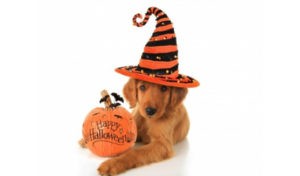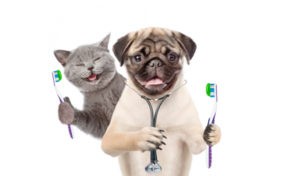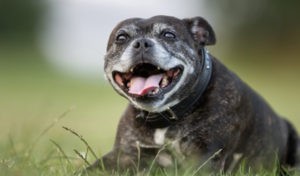 Eeek! Hallowe’en Can Be a Scary Night for Pets!
Eeek! Hallowe’en Can Be a Scary Night for Pets!
Halloween may be a barrel of laughs for those of us who love to dress up in costumes and party, but many pets aren’t quite as fond of the holiday as their owners are. The doorbell rings far too often and is usually accompanied by loud, tiny humans; there’s enough candy to make a pack of goblins sick; and the parties are typically high energy, noisy affairs. With all of these spooky happenings, even the bravest of pet souls may find Halloween a bit frightening, so it’s important to keep your pet’s peace of mind, health, and safety in mind when planning for the holiday.
Let’s Talk Pet Costumes
Super cute internet images may have us all believing that pets and costumes go together like cereal and milk, but your pet may disagree. Much like Ralphie’s dreaded pink bunny costume in “A Christmas Story”, what may be adorable to the viewer can be just plain miserable for the wearer – in this case, our pets. But if your pet is game and enjoys being dressed up, great! Just keep a few key things in mind to help keep your pet safe and comfortable:
- Beware of too-tight costume elastics, which can cause a body part to swell and feel painful, or grab too much hair so that it has the effect of a ponytail pulled painfully tight.
- Bits and pieces of a costume can cause tripping hazards, so make sure your pet’s costume parts don’t dangle far.
- The simple act of putting on and/or wearing a costume can annoy or frighten some dogs when stress is already a bit higher than usual.
- Costumes should be comfy and nonrestrictive so your pet won’t be physically uncomfortable.
Do not use paint directly on your pet.
- Some dogs will try to eat parts of their costumes, so watch your pets constantly while they are wearing one.
- If the costume involves a mask, make sure your pet’s vision is unrestricted.
Home, Sweet Home
During trick-or-treating or Halloween parties, pets can get frightened and bolt out the open door, creating a very real risk for getting hit by a car or hopelessly lost. It’s often best to crate nervous or excitable dogs, or keep dogs and cats in a quiet, comfortable, closed room while trick-or-treaters or party-goers are likely to ring the bell. Make sure your pet is properly identified with an ID tag (and even better – a microchip, too!) in case of accidental escape. Outdoor cats are definitely safest inside on this night of bustling activity. If the activity makes your dog – well, out of his gourd – see what your veterinarian thinks about a sedative for the evening.
Keep Hallowe’en goodies off your pet’s menu
Poisoning is a big problem on Halloween. Cats aren’t generally
interested in candy, but dogs can eat enough of it – and quickly – to
get sick enough to need an ER. Gastrointestinal problems are a
typical result, usually vomiting and diarrhea, but if enough
chocolate is in the mix, or if something contains
xylitol, you could have some very scary,
life-endangering issues.
Remind your children not
to share any candy with pets, even though
it’s sweet of them to want to share their bounty.
Emergency rooms see an increase in both poisoning and foreign object ingestion cases over Halloween. Some dogs will eat plastic parts, such as the stick that comes with lollipops, which may need to be removed surgically. Tin foil candy wrappers can be problematic as well.
Speaking of gastrointestinal problems, some pets can even get stress-related diarrhea as a result of all the noise and activity, so speak with your veterinarian before Halloween if you have big plans and you know your pet is sensitive to changes in his or her environment.
Headed out for tricks & treats?
If you take your dog out treat-or-treating with your family, remember that other dogs and children are wound up with excitement. Keep your dog safe from sudden moves by children, and be aware of other dogs going with their families. Those adorable costumes on children can set off a territorial or fearful response in a dog, either of which could result in a bite (the nicest dogs in the world can bite if they feel threatened or frightened enough).
Also, consider using reflective gear on your dog if you’ll be out and about with the ghosts and ghouls in the dark of Halloween night together.
Cobwebs and candles and whiskers on kittens
Candles and jack-o’-lanterns are a fire hazard whether you have pets or not. Dogs and cats may knock over burning candles, or let curiosity get the better of them so that they stick their faces into a jack-o-lantern (a lucky cat will only singe his whiskers, not lose them entirely!). Other Halloween décor, such as fake cobwebs and dangling decorations, could create a tangling, suffocating, or choking hazard, so keep your pet safely away from them.
Much like a mummy, it’s time to wrap it up!
While Halloween isn’t as noisy or frightening as Independence Day in July (the busiest night of the year for shelters), for some pets, it’s likely in second place as Scariest Holiday of the Year. But don’t get spooked; simply keep your pet away from the frenetic and potentially hazardous parts of the celebration and you’re sure to enjoy a happy Howl-o-ween together!
This blog post was written by McQueen Animal Hospital, a veterinary clinic in Brampton providing quality affordable veterinary care




